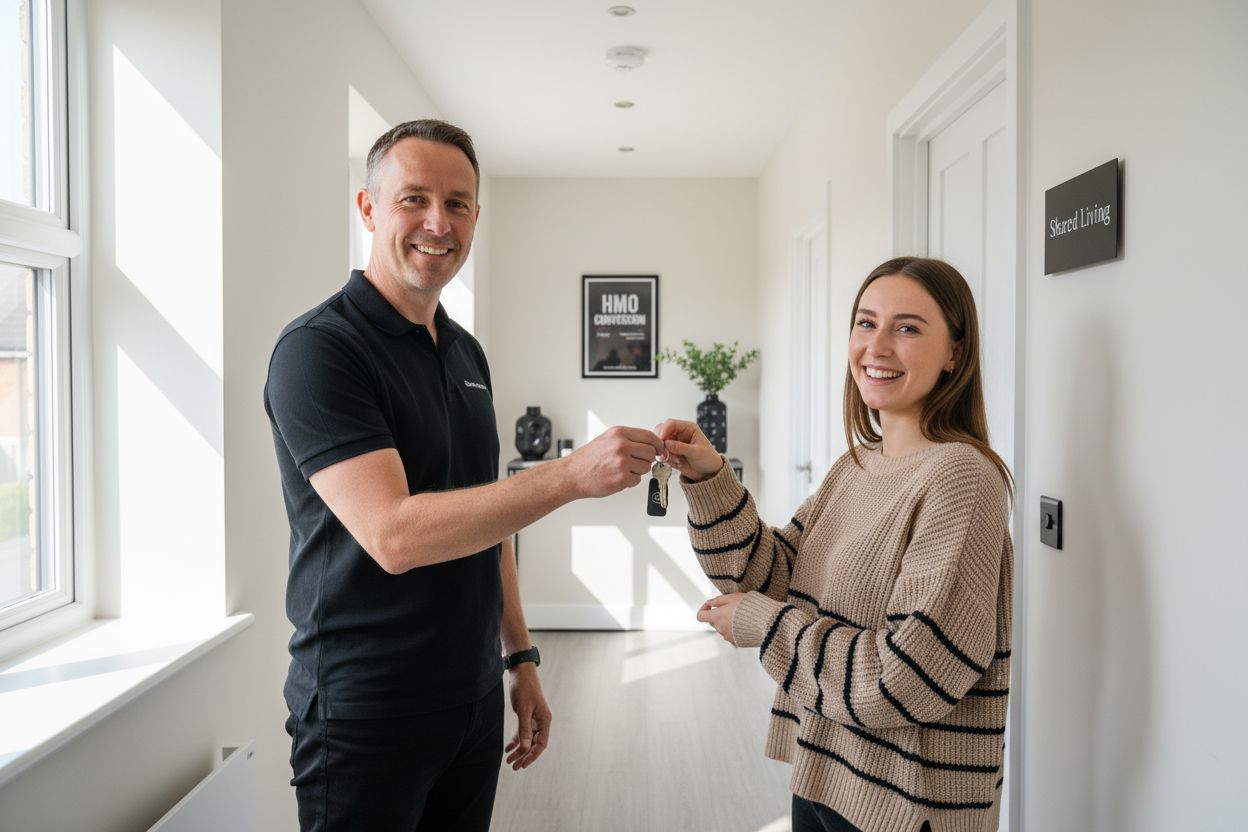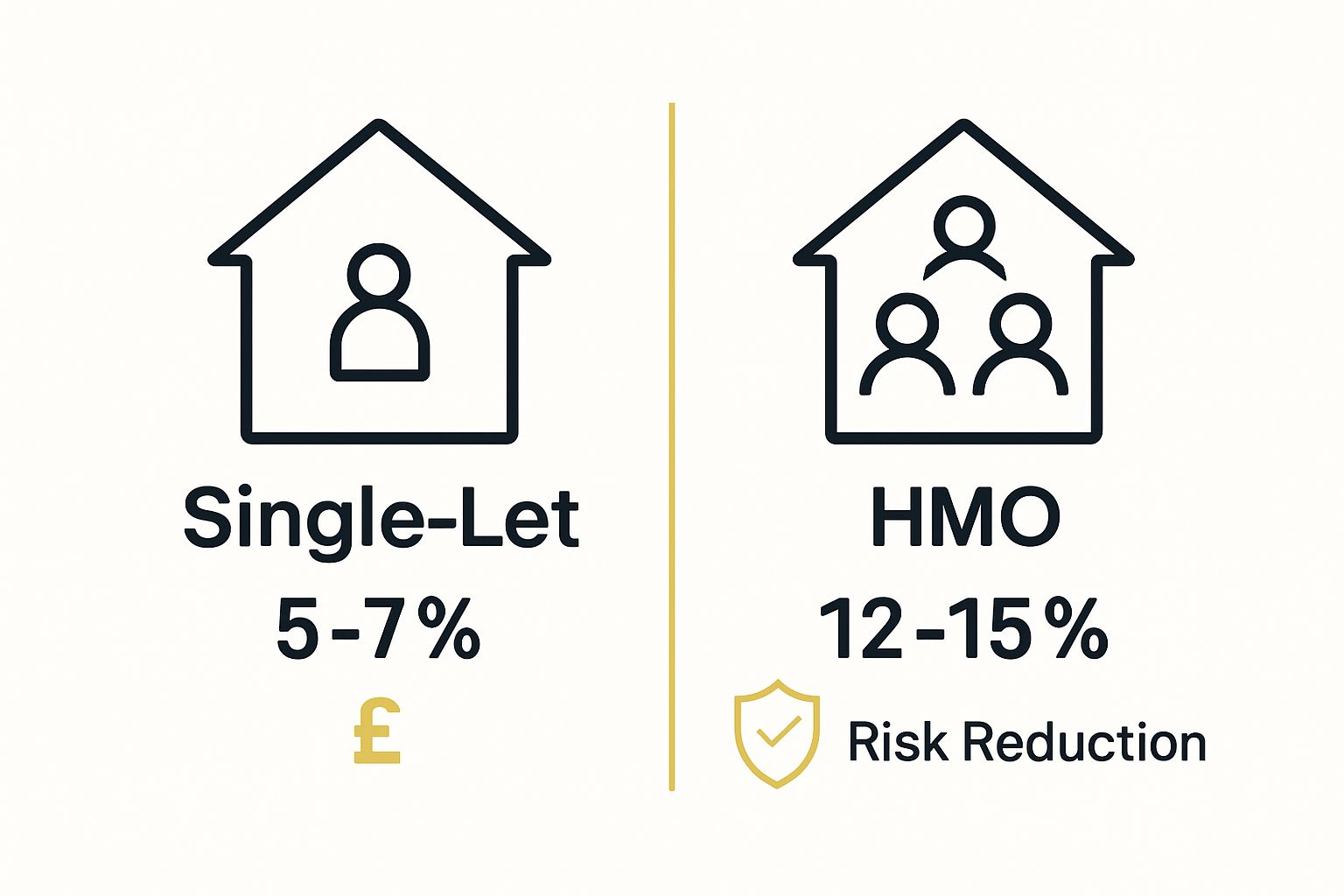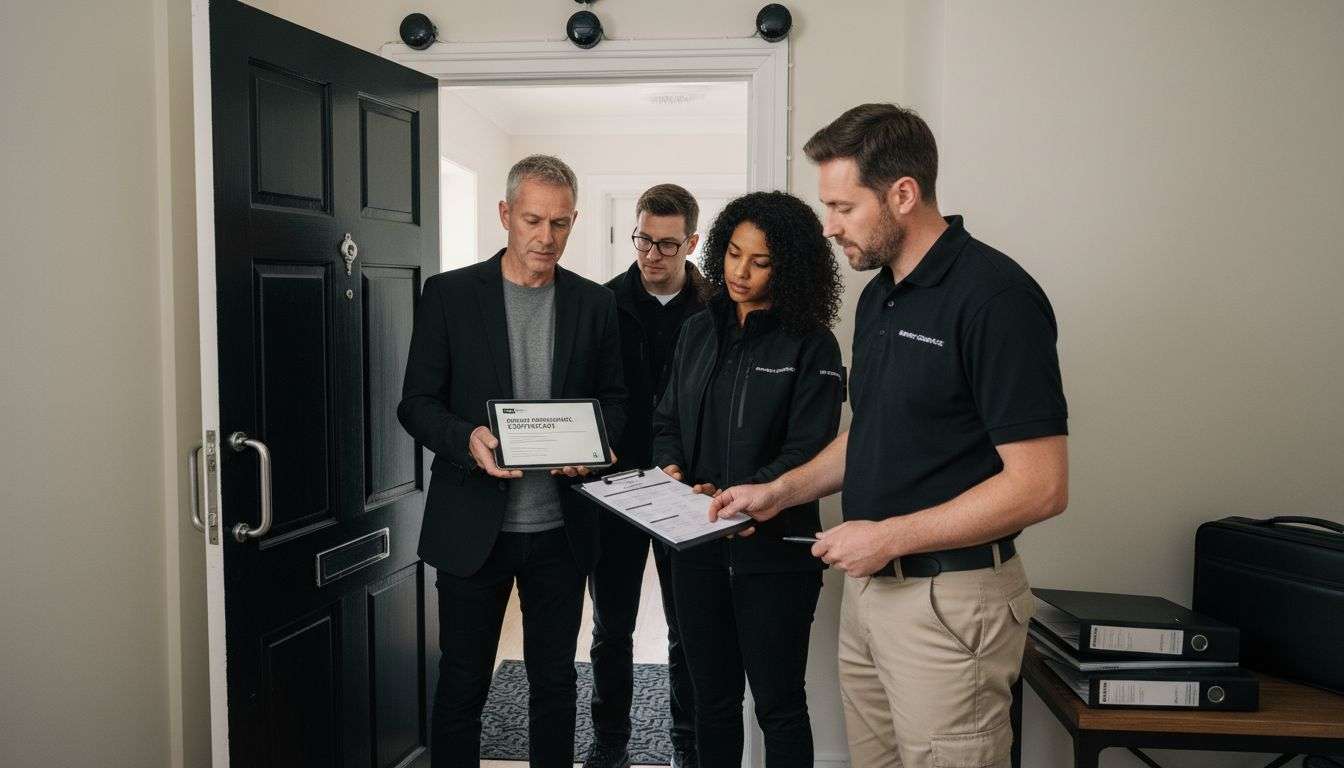HMO properties are reshaping the way investors approach the property market, offering the chance to earn up to three times the rental income compared to traditional single-lets. Most would assume all that extra income comes with cut corners or increased risk. The reality is that HMOs not only open the door to higher returns but also provide safer and more affordable living options for tenants in crowded cities.
Quick Summary
| Takeaway | Explanation |
|---|---|
| HMOs generate higher rental yields | HMO properties can yield 12-15% compared to just 5-7% for single-lets, increasing cash flow significantly. |
| Convert existing properties to HMOs | Transforming single-let properties into HMOs can unlock greater financial returns through increased tenant occupancy. |
| Understand local HMO regulations | Compliance with licensing and safety standards is crucial for successful HMO management and to avoid legal penalties. |
| Multiple tenants reduce income risks | Having several tenants lowers the impact of vacancy, leading to a more stable income stream. |
| HMO benefits both landlords and tenants | HMOs offer landlords better income while providing tenants with affordable and flexible housing options. |
What is an HMO and its significance in property investment?
A House in Multiple Occupation (HMO) represents a distinctive property investment strategy that offers substantial financial advantages for property investors seeking higher rental yields. Unlike traditional single-let properties, HMOs are residential properties where multiple unrelated tenants occupy the same dwelling, sharing essential facilities such as kitchens and bathrooms.
Understanding HMO Property Characteristics
HMOs are legally defined properties where at least three tenants from different households live together, creating a unique residential arrangement. These properties typically include:
- Shared living spaces like kitchens and bathrooms
- Individual private bedrooms for each tenant
- Complex management requirements
- Higher potential for rental income
Investors find HMOs attractive because they generate multiple rental streams from a single property. Discover our comprehensive guide on HMO property management to understand the intricate details of running such properties effectively.
Financial Benefits of HMO Investments
The financial potential of HMO properties significantly outperforms traditional single-let investments. While a standard rental property might generate £800 monthly, an HMO can potentially produce £2,000-£3,000 from the same space by accommodating multiple tenants. According to government regulations, specific licensing requirements exist to ensure tenant safety and property standards.
Key financial advantages include:
- Increased rental yields (potentially 12-15% compared to 5-7% in single-let properties)
- Diversified income streams
- Reduced risk through multiple tenant occupancy
- Potential for faster property value appreciation
Successful HMO investing requires thorough understanding of local regulations, tenant demographics, and property management strategies. Investors must navigate complex legal frameworks, invest in property modifications, and maintain high-quality living standards to create profitable and sustainable HMO investments.
The following table compares key features and differences between HMO properties and traditional single-let properties, highlighting aspects important for property investors and tenants.
| Feature | HMO Property | Single-Let Property |
|---|---|---|
| Rental Income Potential | Higher (up to three times more) | Lower (standard market rate) |
| Tenant Occupancy | Multiple unrelated tenants sharing facilities | Single tenant or household |
| Rental Yield | 12-15% | 5-7% |
| Vacancy Risk | Lower, income from multiple tenants | Higher, income reliant on one tenant |
| Management Complexity | Higher, due to regulations and tenant diversity | Lower, simpler agreements |
| Legal/Regulatory Requirements | Stringent HMO licensing and safety standards | Standard rental regulations |
| Tenant Benefits | Affordable, flexible options in urban areas | Greater privacy but less affordable |
| Property Value Appreciation | Potentially higher due to increased rental profitability | Standard market-led appreciation |
Why does converting to HMO matter for landlords and tenants?
Converting a traditional single-let property to a House in Multiple Occupation (HMO) represents a strategic transformation that delivers substantial benefits for both landlords and tenants, creating a win-win scenario in the competitive property market. The decision to convert goes far beyond mere financial calculations and encompasses broader economic and social dynamics.
Economic Advantages for Landlords
For property investors, HMO conversion unlocks significant financial potential. Landlords can dramatically increase their rental income by reconfiguring existing properties to accommodate multiple tenants. Learn more about HMO conversion strategies to understand the nuanced approach required for successful property transformation.
The economic benefits include:
- Potential rental yield increases from 5-7% to 12-15%
- Multiple income streams from a single property
- Enhanced property asset value
- More resilient investment against market fluctuations
Tenant Benefits and Affordability
Contrary to common perception, HMO conversions also provide substantial advantages for tenants. According to housing market research, HMOs offer more affordable housing options in high-cost urban areas, particularly for professionals, students, and young workers seeking flexible living arrangements.
Tenant advantages encompass:
- Lower individual rental costs compared to standalone apartments
- Shared facilities reducing overall living expenses
- More accessible housing in expensive metropolitan regions
- Opportunities for social interaction and community living
Successful HMO conversion requires careful planning, understanding local regulations, and maintaining high-quality living standards. Landlords must balance financial objectives with tenant comfort, ensuring properties meet stringent safety standards and provide comfortable, functional living spaces.
Ultimately, HMO conversion represents a sophisticated property investment strategy that simultaneously addresses housing affordability challenges and creates robust investment opportunities for forward-thinking landlords.

How does the HMO conversion process work in practice?
Converting a traditional single-let property into a House in Multiple Occupation (HMO) involves a comprehensive and strategic approach that requires meticulous planning, financial investment, and strict adherence to regulatory standards. The transformation process is complex and demands careful consideration of multiple interconnected factors.
Initial Property Assessment and Planning
Successful HMO conversion begins with a thorough property evaluation. Investors must critically analyse the existing property’s layout, structural integrity, and potential for reconfiguration. Explore our detailed guide on HMO licensing requirements to understand the critical legal considerations before commencing conversion.
Key initial assessment criteria include:
- Current property dimensions and spatial layout
- Potential for bedroom and communal space configuration
- Existing structural condition and required modifications
- Compliance with local HMO licensing regulations
Technical Modifications and Compliance
The technical conversion process involves substantial property modifications to meet rigorous safety and habitability standards. According to government housing regulations, HMO properties must satisfy specific requirements to obtain necessary licences.
Critical modification considerations encompass:
- Installing additional bathroom and kitchen facilities
- Ensuring adequate fire safety mechanisms
- Creating individual lockable bedroom spaces
- Implementing robust soundproofing between rooms
- Upgrading electrical and heating systems
Financial and Regulatory Navigation
Beyond physical transformations, successful HMO conversion requires sophisticated financial planning and regulatory compliance. Investors must secure appropriate financing, obtain necessary permits, and develop comprehensive management strategies. The process demands significant upfront investment but offers potentially lucrative long-term returns through diversified rental income streams.
Navigating the HMO conversion landscape requires a strategic blend of technical expertise, financial acumen, and thorough understanding of local housing regulations. Successful investors approach this process as a holistic investment strategy rather than a simple property modification project.
This table summarises the typical process for converting a single-let property into an HMO, outlining each stage and its key considerations.
| Stage | Description |
|---|---|
| Property Assessment & Planning | Evaluate property layout, structural suitability, and conversion feasibility |
| Regulatory Review & Licensing | Investigate local HMO licensing requirements and compliance obligations |
| Technical Modifications | Upgrade facilities, add bedrooms, kitchens, bathrooms, fire safety etc. |
| Safety & Compliance Upgrades | Implement measures for fire, electrical, and gas safety |
| Finances & Permits | Secure funding, obtain permits, and plan for renovation costs |
| Management Strategy | Develop a robust plan for tenant management and ongoing compliance |
| Final Inspection & Occupation | Conduct inspections and begin tenant occupancy |
What are the financial benefits of choosing HMO properties?
HMO properties represent a sophisticated investment strategy that transcends traditional property investment models, offering unprecedented financial advantages for forward-thinking investors. By reimagining residential spaces, investors can unlock substantial economic potential through innovative rental approaches.
Enhanced Rental Income Streams
The primary financial attraction of HMO properties lies in their ability to generate multiple income streams from a single property. Unlike conventional single-let properties, HMOs enable investors to collect rent from several tenants simultaneously. Explore our comprehensive guide on HMO mortgage strategies to understand the financial intricacies of this investment approach.
Key income generation advantages include:

- Potential rental yields increasing from 5-7% to 12-15%
- Reduced income volatility through diversified tenant base
- Consistent cash flow even during individual tenant turnovers
- Higher total monthly rental compared to single-let properties
Risk Mitigation and Investment Resilience
According to parliamentary research briefings, HMO properties offer superior financial resilience compared to traditional rental investments. The multi-tenant model inherently provides a buffer against potential rental income disruptions.
Risk mitigation benefits encompass:
- Lower financial impact of individual tenant vacancies
- More stable overall investment performance
- Reduced dependency on single tenant agreements
- Enhanced property value appreciation potential
Long-Term Wealth Generation Strategy
Beyond immediate rental income, HMO properties represent a strategic long-term wealth generation approach. Investors can progressively build a robust property portfolio by leveraging the unique financial dynamics of multi-occupancy residential spaces. The combination of higher rental yields, decreased risk, and potential property value appreciation makes HMO investments an attractive option for sophisticated property investors seeking sustainable financial growth.
Understanding the legal obligations and implications of HMOs
Navigating the legal landscape of Houses in Multiple Occupation (HMOs) requires a comprehensive understanding of complex regulatory frameworks designed to protect tenants and ensure property standards. Successful HMO management demands meticulous compliance with a sophisticated array of legal requirements that extend far beyond traditional rental property regulations.
Licensing and Regulatory Compliance
HMO properties are subject to stringent licensing requirements that vary based on property size, tenant composition, and local authority regulations. Explore our detailed HMO legal checklist to understand the intricate compliance requirements for property investors.
Critical licensing considerations include:
- Mandatory HMO licensing for properties housing five or more tenants
- Mandatory safety certifications and inspections
- Specific fire safety and emergency exit requirements
- Regular property condition assessments
Safety and Tenant Protection Standards
According to government housing regulations, HMO landlords must meet comprehensive safety and welfare standards that significantly exceed traditional rental property requirements. These regulations aim to protect vulnerable tenants and ensure minimum living standards across multi-occupancy properties.
Key safety and protection obligations encompass:
- Comprehensive fire safety systems and equipment
- Adequate sanitation and bathroom facilities
- Proper electrical and gas safety certifications
- Clear emergency evacuation protocols
- Minimum room size and occupancy standards
Financial and Legal Consequences of Non-Compliance
Failure to meet HMO legal requirements can result in substantial financial penalties and legal repercussions. Local authorities possess significant enforcement powers, including substantial fines, mandatory improvement notices, and potential criminal prosecution for persistent violations.
Potential consequences of non-compliance include:
- Substantial monetary penalties up to £30,000
- Potential criminal prosecution
- Mandatory rent repayment orders
- Revocation of property letting permissions
- Damage to professional reputation
Successful HMO property management requires a proactive approach to legal compliance, combining rigorous understanding of regulatory frameworks with consistent implementation of safety and tenant welfare standards.
The table below organises the main legal obligations for HMO landlords, providing a concise overview of requirements and their associated purposes.
| Obligation | Description / Purpose |
|---|---|
| Obtain Mandatory HMO Licence | Legal requirement for properties with five or more tenants |
| Fire Safety Measures & Equipment | Protects tenant welfare and ensures emergency preparedness |
| Safety Certifications (Electrical, Gas) | Validates safe operation of property facilities |
| Minimum Room Size Standards | Ensures adequate living space and avoids overcrowding |
| Regular Property Inspections | Maintains habitable and safe conditions |
| Emergency Exit Routes | Guarantees safe evacuation in emergencies |
| Sanitation & Bathroom Provision | Meets health and hygiene standards |
Unlock Profitable HMO Property Opportunities With Expert Support
Are you struggling with the complexities of converting to an HMO and feeling unsure about navigating licensing, compliance, or maximising rental yields? The journey from single-let to HMO can be overwhelming, filled with legal obligations, renovation challenges, and the need to ensure sustainable returns. Whether you are looking to boost your income, manage multiple tenants seamlessly, or understand your next steps in compliant investment, finding the right guidance is crucial.
At AgentHMO, you can access dedicated resources that take you from understanding the financial advantages of HMO properties to practical actions such as finding trusted estate agents and professional partners or exploring firsthand property listings for your next investment. The platform brings together tools, property valuations, and a network of service providers who know the intricacies of the UK HMO market. Do not let uncertainty hold your HMO ambitions back. Visit AgentHMO today and take the next step towards building a compliant, lucrative HMO portfolio.
Frequently Asked Questions
What are the main financial advantages of converting to an HMO?
Converting to an HMO can significantly increase rental yields, often rising from 5-7% to 12-15%, allowing landlords to generate multiple income streams from a single property while reducing the risk associated with tenant vacancies.
What key modifications are necessary during HMO conversion?
Essential modifications typically include adding more bathroom and kitchen facilities, ensuring fire safety compliance, creating individual lockable bedrooms, and upgrading electrical and heating systems to meet safety and habitability standards.
How do HMO properties differ from traditional single-let properties?
HMO properties accommodate multiple unrelated tenants sharing communal facilities, whereas traditional single-let properties are rented to one tenant or household. This difference enables HMOs to provide higher rental income potential from a single property.
What legal obligations do landlords need to fulfil for HMO properties?
Landlords must comply with various legal requirements, including obtaining mandatory HMO licenses, ensuring safety certifications, meeting fire safety standards, and adhering to regulations regarding the minimum size and condition of living spaces.



